ASM Metals HandBook Vol. 17 - Nondestructive Evaluation and Quality Control
Подождите немного. Документ загружается.

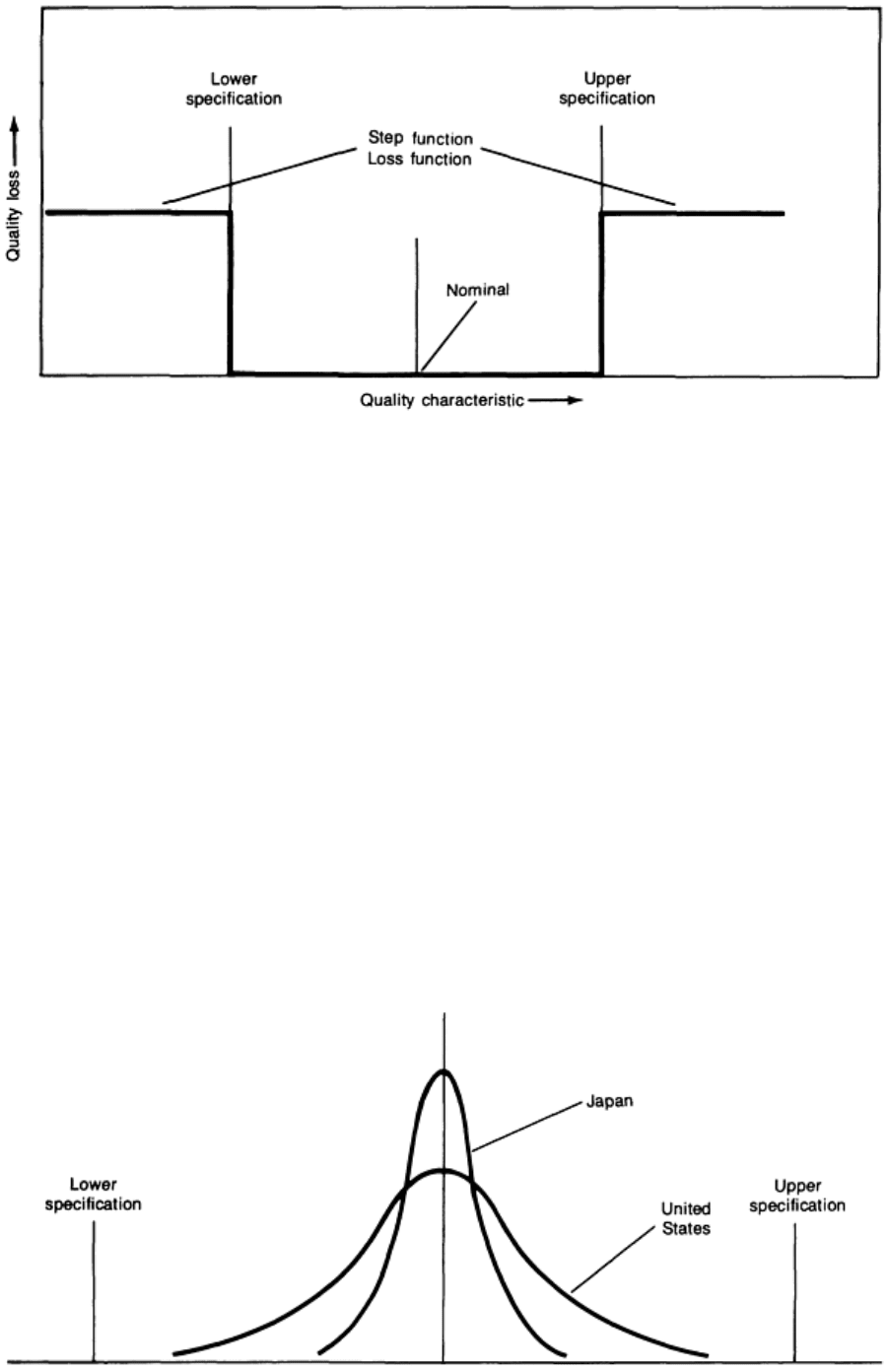
Fig. 3 Plot of quality loss versus quality characteristic to illustrate loss function of engineering specification
Variation Reduction and the Loss Function. The loss function view of quality suggests that there exists a clear
economic advantage to reducing variation in the performance of a product. The case study described below clearly
indicates how such reduced manufacturing imperfection can lead to a reduction in costs and therefore an improvement in
competitive position.
Several years ago an automobile company performed a study to compare the manufacturing variations evident in certain
transmission components for comparable transmissions made in the United States and in Japan. Random samples of
transmissions were selected in each case. The transmissions were disassembled, and a number of critical dimensions were
measured and recorded.
Figure 4 illustrates the general findings of the study. In particular, in the case of the U.S. transmissions, the critical
dimensions generally consumed about the middle 75% of the tolerance range specified. Normally, one would conclude
that the capabilities associated with the manufacturing processes are therefore well within normal expectations. However,
the same critical dimensions for the Japanese counterpart of this transmission consumed only about the middle 25% of the
same tolerance range. The question that begs to be asked is, Why would the Japanese strive to make the parts to such tight
tolerances?
Fig. 4
Comparison of critical dimensions for transmission components manufactured in the United States versus
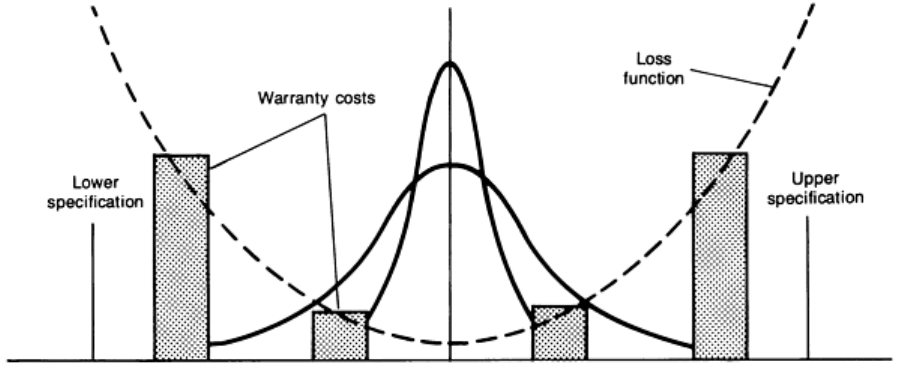
those manufactured in Japan
The warranty cost bars shown in Fig. 5 have been plotted at the extremes of the two distributions of the critical
dimensions to depict the relative costs associated with variability. It is clear that for the U.S. transmissions the cost
associated with repair and replacement is significantly larger than that for their Japanese counterparts. This comparison of
the economic data associated with the two transmissions would suggest that there exists a definite relationship between
variability and cost in terms of loss incurred due to functional variation. One could think of the warranty costs as literally
mapping out the loss function.
Fig. 5 Loss function interpretation of the engineering specifications in Fig. 4 in terms of warranty costs
Robust Design Approach to Quality Design
The design process in general and the design/manufacturing interface in particular have received considerable attention
over the past 20 years. Computer-aided design and manufacture has dealt primarily with the computerization of the design
and manufacturing processes and in particular with the translation of design specifications into manufacturing procedures
and activities. The computer has greatly facilitated this translation, and as a result, lead times have been reduced. Design
modeling and analysis have been strengthened and extended. Standardization and rationalization of both design
characteristics and manufacturing process characteristics have been advanced, and the efficiency of the interactive process
at the design/manufacturing interface has been improved.
The concepts of design for manufacturability and design for assembly have been the subject of considerable research and
development. Numerous specific models have been proposed and refined and will not be discussed here. This work is
aimed at overcoming the difficulties precipitated by the traditional over-the-wall design philosophy.
The magnitude of the problem with the over-the-wall approach to design and manufacturing can perhaps be measured in
terms of the number of times the part drawing is thrown back and forth over the wall. As the initial design concept
progresses from prototype testing and development to final design detailing and ultimately to the initiation of production
and beyond, the number of design interactions has in the past been too high. In Ref 9, typical Japanese and U.S.
companies are contrasted in this regard with an illustration similar to Fig. 6.
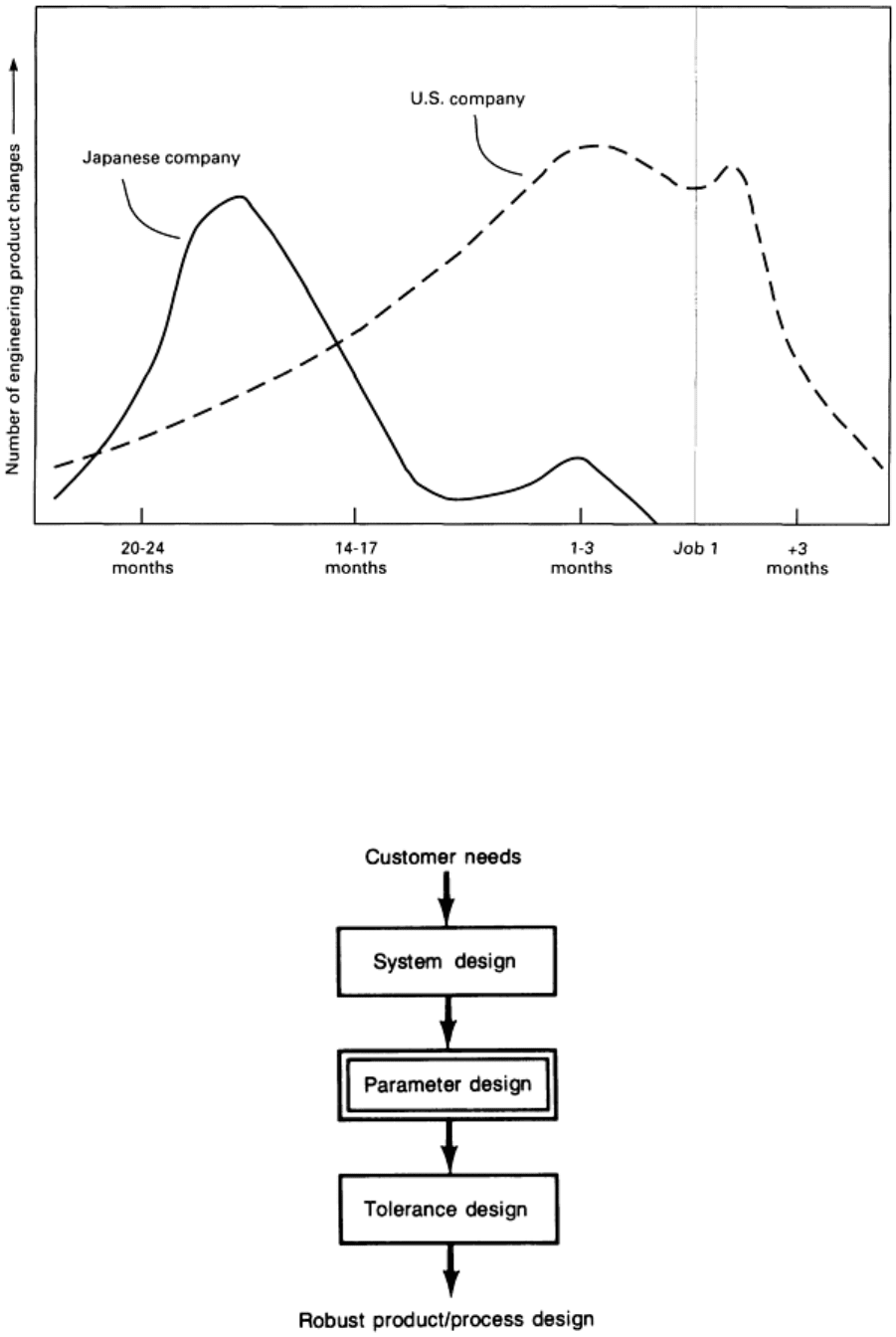
Fig. 6 Comparison of Japanese and American product design life cycles
Taguchi methods have strong engineering orientation and focus primary attention on the engineering design process,
particularly the projection of a three-stage design process model of system design, parameter design, and tolerance design.
Figure 7 illustrates the Taguchi design process model (Ref 4, 5).
Fig. 7 Block diagram illustrating Taguchi's three-stage design process model

Systems Design Stage. In the initial stage, systems design (the available science, technology, and experience bases)
is used to develop and select the basic design alternative to meet customer needs. A variety of techniques may be useful in
specifically mapping the relationship between customer needs and the selection of design configuration and parameters
that will effectively meet those needs. The methods of quality function deployment may be most useful at this stage of the
design process.
At the parameter design stage, interest focuses on the selection of the specific nominal values for the important
design parameters. The overarching selection criterion is to identify those nominal values that minimize the transmission
of functional variation to the output performance as a result of the presence of noise factors. It is at the parameter design
stage that Taguchi strongly advocates the use of design of experiments methods.
The tolerance design stage of the design process concentrates on the selection of allowable tolerances for the
important design parameters. The loss function concept of quality is used to provide a basis for striking the proper
economic balance in the selection of design.
Product/Process Performance Factors. Taguchi suggests an engineering interpretation of the varying roles that
the important system factors/variables play in influencing product/process performance. Taguchi emphasizes the
importance of evaluating quality performance as part of the design process. Taguchi classifies the factors that can
influence product/process performance into four categories:
• Signal factors: Factors that can be adjusted by the user to attain the target perfo
rmance. Steering angle,
for example, is a signal factor for the steering mechanism of an automobile
• Control factors:
Product/process design parameters whose values are to be determined during the design
process. One design activity is to select the optimu
m levels of the control factors according to an
appropriate design criterion
• Noise factors:
Factors that are either inherently uncontrollable or impractical to control because of
technological/economic reasons. Taguchi further classifies these into outer and inner noises
• Scaling/leveling factors:
Special cases of control factors. They are factors that can be easily adjusted to
achieve a desired functional relationship between a signal factor and the output response. For example,
the gearing ratio in a ste
ering mechanism can be easily adjusted to achieve a desired relationship
between the turning radius and the steering angle
Signal factors are those variables adjusted to attain the target/nominal performance. The control factors are those variables
under the control of the designer. Selection of the nominal values for the control factors is the primary role of parameter
design. Noise factors describe those variables that are difficult or impossible to control but whose variation is analyzed to
understand the way it is transmitted to the output quality. To minimize the effects of outer and inner noises on product
quality, certain countermeasures can be taken. The most important of these countermeasures is that of design. A product
is said to be robust if its design is such that its performance is minimally influenced by uncontrollable noise factors.
An automobile design can be said to be robust if, for example, the fuel economy remains fairly constant over a wide range
of speeds, road conditions, and wind velocities. This is shown graphically in Fig. 8.
Fig. 8
Effect of three noise factors on automotive fuel efficiency (mpg) to demonstrate a robust product (Car
A). Car A offers peak performance over a wide range of conditions for all three factors,
while Car B offers peak

performance over a limited range of conditions for each individual factor.
References cited in this section
1.
W.W. Scherkenbach, The Deming Route to Quality and Productivity: Road Maps and Roadblocks,
Mercury
Press/Fairchild Publications, 1987
2.
J.M. Juran, Juran on Planning for Quality, The Macmillan Free Press, 1986
3.
A.V. Feigenbaum, Total Quality Control, McGraw-Hill, 1983
4.
G. Taguchi and Y. Wu, Introduction to Off-Line Quality Control, Central Japan Quality Control As
sociation,
1979
5.
G. Taguchi, On-Line Quality Control During Production, Japanese Standards Association, 1981
6.
R.A. Fisher, Design of Experiments, 8th ed., Hafner Publishing, 1966
7.
G.E.P. Box and J.S. Hunter, The 2k-p Fractional Factorial Designs, Part I and Part II, Technometrics,
Vol 3,
1961
8.
G.E.P. Box, W.G. Hunter, and J.S. Hunter, Statistics for Experimenters, John Wiley & Sons, 1978
9.
L.P. Sullivan, Reducing Variability: A New Approach to Quality, Qual. Prog., Vol 17 (No. 7), 1985, p 15-21
Statistical Quality Design and Control
Richard E. DeVor, University of Illinois, Urbana-Champaign; Tsong-how Chang, University of Wisconsin, Milwaukee
Sources of Variation and Their Countermeasures
To reduce functional variation, that is, to increase the consistency of product/process performance, it is essential to
identify the basic sources of functional variation so that appropriate countermeasures can be formulated and implemented.
Taguchi suggests that variations in product or process function (also known as functional variations) arise from three
basic sources (Ref 4):
• Outer noise: External sources or factors th
at are operating in the environment in which the product is
functioning and whose variation is transmitted through the design to the output performance of the
product. Examples of outer noise factors are temperature, humidity, contaminants, voltage fluctua
tions,
vibrations from nearby equipment, and variations in human performance
• Inner noise:
Internal change in product characteristics such as drift from the nominal over time due to
deterioration. Inner noise can be precipitated by such factors as mechanical wear and aging
• Variational noise:
Variation in the product parameters from one unit to another as a result of the
manufacturing process. For example, the design nominal for a resistor may be 200 Ω
; however, one
manufactured resistor may have a resistance of 202 Ω, while another may have a resistance of 197 Ω
The significance of the recognition of the above sources of variation becomes evident as one begins to think in terms of
the fundamental countermeasures one might invoke to mitigate the forces of these sources of variation. It quickly
becomes clear that the forces of outer noise and inner noise can only be effectively dealt with upstream by the engineering
design process. Variational noise is a matter of manufacturing imperfection and can therefore be dealt with, in part, at the
process with such techniques as statistical process control. However, mitigating the forces of variational noise should also
be considered to be a product and process design issue. In fact, it is likely that variational noise can be dealt with in a
more significant and fundamental way if it is thought of as a process and product design problem. Certainly the concept of
design for manufacturability and the current emphasis on the simultaneous engineering of products and processes have
bearing on this issue.
Figure 9 illustrates how the sources of variation defined above are transmitted to the quality response of the product. At
the product design stage, the nominal values of the critical design parameters are selected to produce a prespecified level
of performance in the product in terms of one or more quality responses. Sources of variation active in the manufacturing
processes for the product cause the design parameters to vary from those values intended by the design process, and this
introduces variation into the quality response. Once the product is put into field use, outer noise sources of variation
active in the environment in which the product is being asked to function are transmitted through the design and introduce
further variation in the quality response. For example, variation in temperature may cause product performance to vary.
As time goes by and the use of the product continues, the forces of inner noise are transmitted through the design and
introduce still further variation into the quality response. For example, as a result of wear, a critical design parameter
(size, resistance, viscosity, and so on) will actually change, thus causing a change in quality performance. From Fig. 9 it is
clear that sources of variation enter the picture and affect the ultimate performance of the product during manufacturing
and field use.
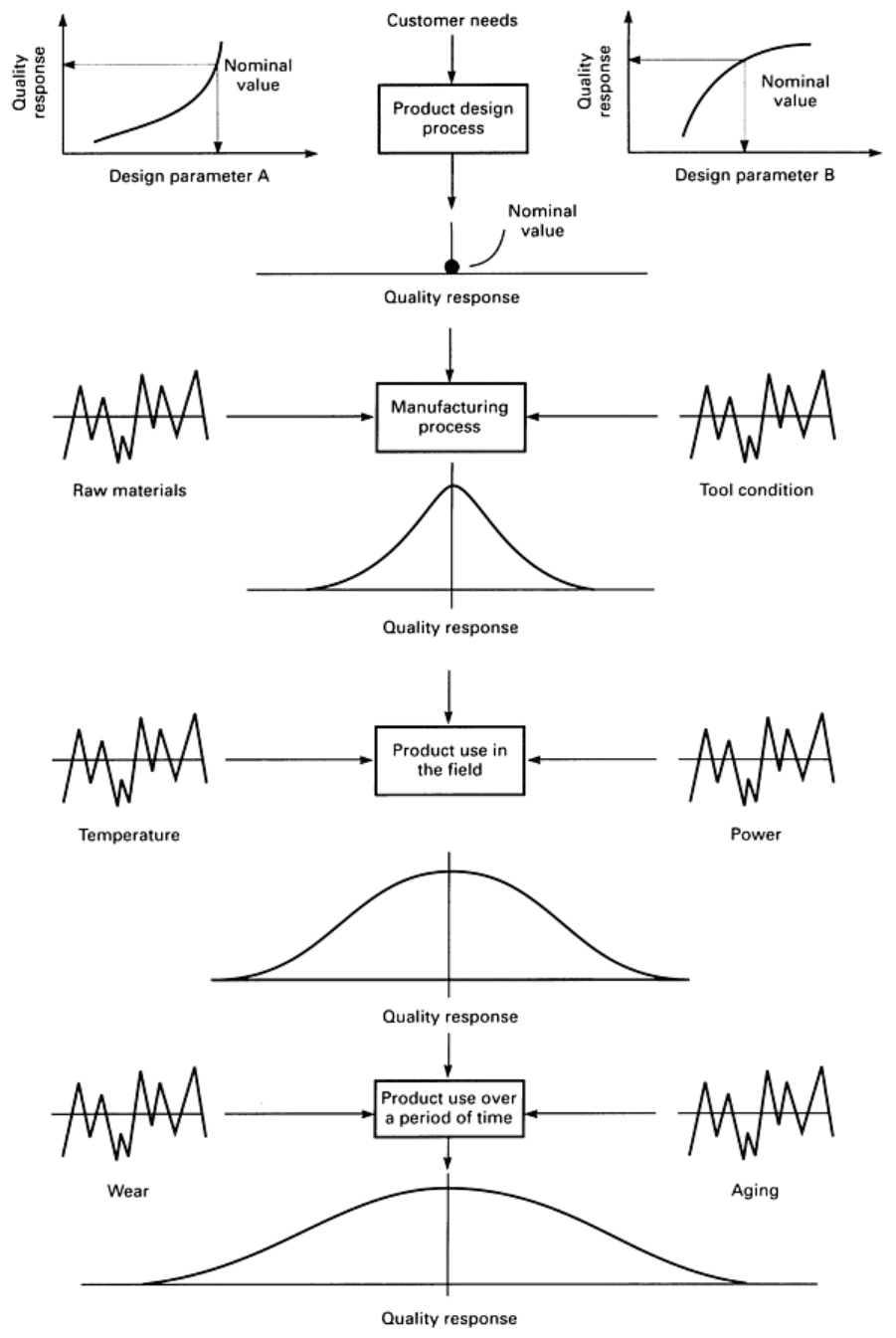
Fig. 9
Block diagram illustrating the impact of numerous sources of variation on the quality performance of a
product from conception to eventual discard
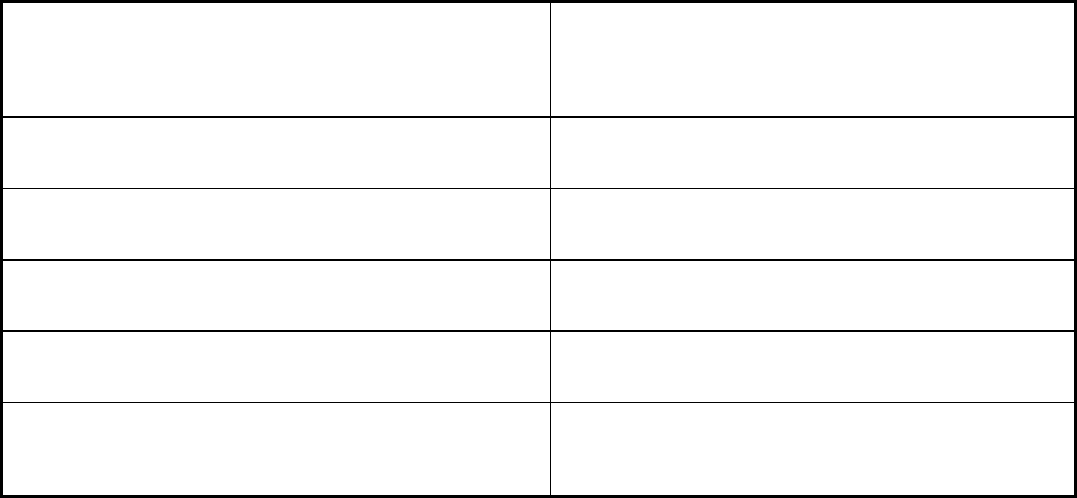
Shewhart (Ref 10), Deming (Ref 11), and Juran (Ref 12) all clearly point out that quality and productivity problems at the
process fall into two basic categories. Shewhart described the variation in the process as arising from either chance causes
or assignable causes. Deming refers to systems faults and local faults, while Juran refers to chronic problems and sporadic
problems. Each provides a lucid description of the overall situation. Assignable causes, local faults, or sporadic problems
arise in a somewhat unpredictable fashion and can usually be dealt with effectively at the workstation by the immediate
level of supervision or the operator. On the other hand, system faults/chance causes/chronic problems are ever present,
influencing all of the production until the system is changed. It is the attack on the system problems that Deming stresses,
because about 80 to 85% of all the problems encountered are of this nature, while only 15 to 20% are of a local nature.
All processes are subject to local faults and system faults:
Local faults
Special causes
Sporadic problems
System faults
Common causes
Chronic problems
Broken tools Poor supervision
Jammed machine Poor training
Material contamination Inappropriate methods
Machine setting drift Poor workstation design
Correctable locally, at the machine, by the operator or first level of
supervision
Requires a change in the system; only management can
implement changes
In the case of common causes, it is clear by their very nature that management must take the responsibility for their
removal. Only management can take the actions necessary to improve the training and supervision of the workers, only
management can take the responsibility for the redesign of a poor workstation layout, and only management can establish
new methods or procedures. Clearly, it is essential that these two types of problems be properly differentiated so that
responsibility can be assigned for solving them.
Process Behavior Over Time
A succession of parts emanating from a process under statistical control will exhibit variability in their measurements
because of a constant set of common causes. These variable measurements tend to collect into a predictable pattern of
variation that can be easily described by a few simple statistical measures; namely, a mean, a standard deviation, and a
frequency distribution. These measures stand as a model that predicts how the process will behave if subject only to a
constant set of common causes. Figure 10 illustrates how such a statistical model may emerge in the manufacture of
automobile head gaskets. The gasket thickness (Fig. 10a) is the quality characteristic of interest.
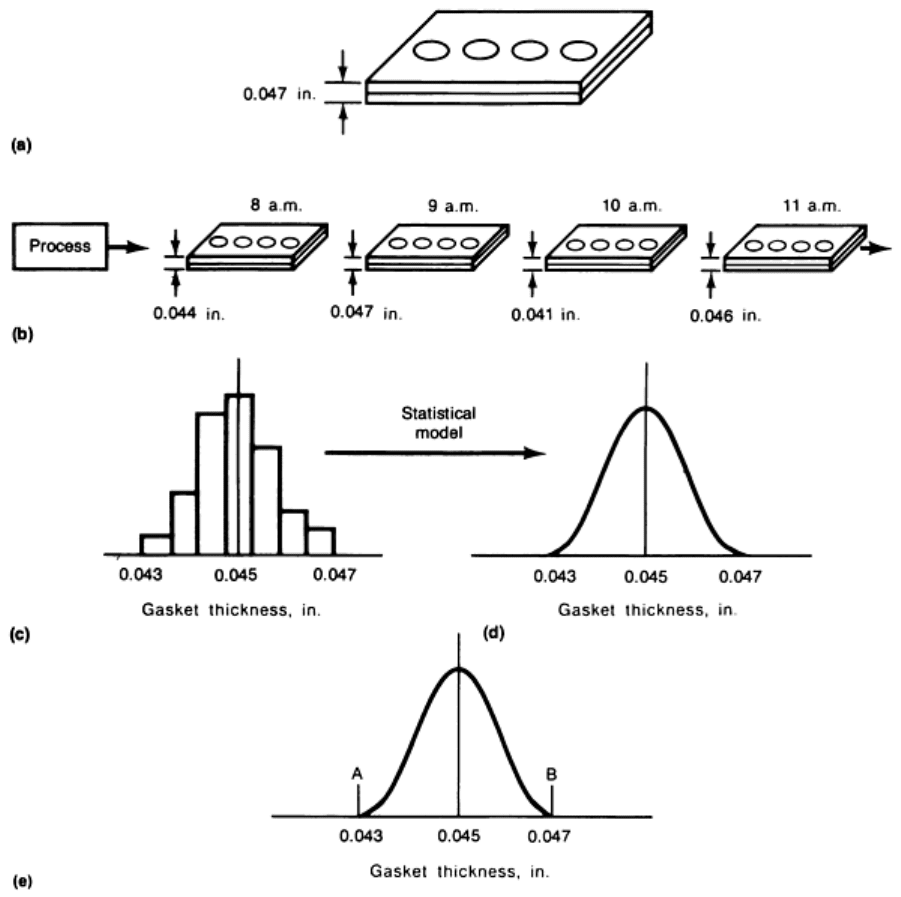
Fig. 10 Schematic and statistical analysis of
an automobile head gasket to demonstrate variability of the
manufacturing process. (a) Gasket thickness specification. (b) Gasket thickness measurements taken of
samples produced at 1-h intervals. (c) Histogram of mean gasket thickness. (d) Plot showing s
tandard deviation
of gasket thickness. (e) Plot showing distribution of gasket thickness measurements
Measurements of thickness can be recorded for a succession of gaskets produced by the process (Fig. 10b), and these data
can be summarized by statistical measures, such as an average (Fig. 10c), a standard deviation (Fig. 10d), and a
distribution (Fig. 10e). If a model can be developed for the process measurements when subject only to a constant system
of common causes, then when a major disturbance affects the process measurement it will be seen not to conform to this
model. It will clearly stand out in the common cause variability pattern.
Time Order of Production. Although the above statistical description and the interpretation of data are useful, they
ignore a crucial characteristic of the data: the time order of production. To properly indicate statistical control or lack of
it, the model must be considered as it evolves over time of production. Figure 11 shows the time order evolution of the
process. In Fig. 11(a), the process mean and variation stay constant over time, and the process is said to be in statistical
control. In Fig. 11(b), a process mean shift occurs at 11:30 a.m. The process is said to have gone out of control. A process
can be subject to several types of disturbances (special causes) that can produce a variety of unstable behaviors with
respect to either its mean level or the level of variability or both.

Fig. 11 Changing process behavior over a 5-
h time interval. (a) Process in statistical control. (b) Stable
variability but out-of-control process due to sustained shift in process mean at 11:30 a.m.
Process Control and Process Improvement
Many years ago, Dr. Walter Shewhart showed how such data from a manufacturing process could be developed and
interpreted through the use of very simple but profound statistical methods. In his benchmark book on the subject,
Economic Control of Quality of Manufactured Product, Shewhart establishes from the very beginning the overarching
philosophy that drives the control chart concept (Ref 10). The first paragraph of the Preface of this work clearly sets the
foundation for what is known today as statistical control:
"Broadly speaking, the object of industry is to set up economic ways and means of satisfying human wants and in so
doing to reduce everything possible to routines requiring a minimum amount of human effort. Through the use of the
scientific method, extended to take account of modern statistical concepts, it has been found possible to set up limits
within which the results of routine efforts must lie if they are to be economical. Deviations in the results of a routine
process outside such limits indicate that the routine has broken down and will no longer be economical until the cause of
trouble is removed" (Ref 10).
From the above statement, several factors become immediately obvious:
• The fundamental focus is on the process--"ways and means of satisfying human wants"
• The overarching objective is economic operation of the process--
"reduce everything possible to routines
requiring a minimum amount of human effort"
• During normal operation, process behavior falls within predictable limits of variation--"It h
as been
found possible to set up limits within which the results of routine efforts must lie if they are to be
economical"
•
Deviations in performance outside these limits signal the presence of problems that are jeopardizing the
economic success of the process--
"Deviations in the results of a routine process outside such limits
indicate that the routine has broken down and will no longer be economical"
• Improvement in quality and productivity requires that attention be directed at the process to find the ro
ot
cause of the trouble and remove it--
"the routine has broken down and will no longer be economical until
the cause of trouble is removed"
In addition, there is no mention of the product and the conformance of the product to specifications in the above statement
from Shewhart. The total emphasis is on the process and its economic operation.
Bringing a process into a state of statistical control does not necessarily mean that a fundamental improvement has been
achieved. Clearly, a bad situation has been rectified by bringing the process into control, and quality and productivity are
enhanced. However, bringing a process into control simply means that the process is back to where it should have been to
begin with. At this point, it is then possible to begin to assess the present ability of the process to realize the potential it
was initially intended to have. It may be failing to realize this potential because the implementation of the process is
flawed or because the design of the process itself is flawed. In either case, the root cause(s) of the chronic common cause
problem must be identified and removed at the system level. This constitutes a breakthrough in performance; that is, an
improvement in the process has taken place. The results of the essential steps leading to such a breakthrough are shown in
Fig. 12.
